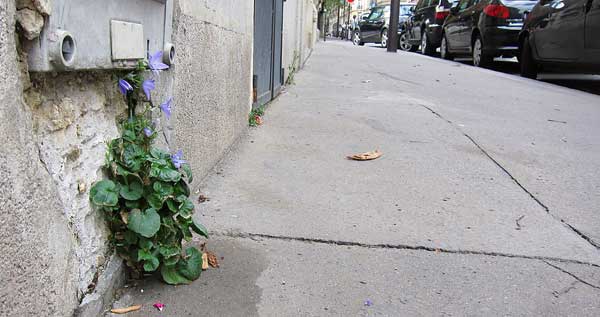
Who could fail to admire the weeds? Especially weeds impervious to weeding, weeds we make war on, weeds that persist no matter how many times they get pulled up by the roots and pitched. Outside my house there’s a parking strip, a city-owned expanse of dirt between sidewalk and curb, that I have endeavored to grace with a garden. Ha ha. I am a sporadic and inattentive gardener, and the weeds know it.
My nemesis is buckhorn plantain (Plantago lanceolata), though I’m not its nemesis; in fact I hardly bother it at all. It has narrow spearlike leaves that rise from its base. Then there are two or three stems, bearing what Arthur Lee Jacobson, in his entertaining Wild Plants of Greater Seattle, refers to as “tiny cylindrical congestions of wind-pollinated flowers.” I like the suggestion of congestion, as in backed-up traffic or a bad cold.
Weeds grow in weedy places—cement cracks, dry curbs, ditches, dumps, alleyways forgotten by all but defecating dogs. The aforementioned buckhorn plantain has been noted growing straight out of asphalt between street and cement curb. Weed here, and you risk your life from speeding cars. Does this weed know what it’s doing?
When I do dig one up though, I feel virtuous. I feel accomplished. I feel deeply satisfied.
I do, however, love the money plant, also called silver dollar plant (Lunaria annua), that member of the mustard family, that two-foot-tall weed with hairy heart-shaped leaves and purple flowers and silver-dollar-sized seedpods. Money plants proliferate in a patch of the parking strip under the chaste tree, taking the place of the deadly nightshade that once grew there. (Where did that deadly nightshade go? When did it go? I’m about as observant as the telephone pole.)
My neighbor Barbara cannot abide the money plant. My money plants seed her garden, and she rips them right out. But she steals seeds from my rose campions (if you can call stealing seeds from weeds stealing) and sows them in her garden. I adore the rose campion (Lychnis coronaria) with its furry grayish-green rabbit-ear leaves and bright little magenta flowers. I adore red clover, and I adore the yarrows and the Queen Anne’s lace. But I curse Shepherd’s purse (Capsella bursa-pastoris), with its triangular seedpod, which resembles, if we even care, an old-fashioned shepherd’s purse.
And what of crabgrass, pigweed, chickweed, buttercup, dandelion, columbine, borage? What of burdock, that bearer of sticky burrs? What of the stickers—nettles and thistles?
The weeds of childhood may remain alive in our psyches, we who have grown far afield, who now live elsewhere and otherwise. My childhood weeds included buttercups lining the dirt road, good for yellow petal powder. They included milkweed, its fat seedpod packed with white parachute fluff provided for children to fling into air. They included goldenrods yellowing entire fields and wild asparagus and greenbriar and honeysuckle.
Weeds just won’t go away. They will not be moved. They refuse to die. They stubbornly grow among cement and gravel and old tires, putting their bit of oxygen into the air as plants are wont to do. Some are native, others invasive. It helps to learn their names. For a good many of us, they are nature’s most familiar face.

